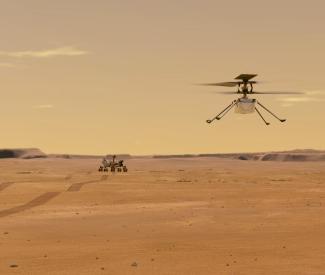
Figure caption: Perseverance and Ingenuity on Mars**
As part of his wider scientific interests, Professor Leighton recently co-authored a research paper* on the sounds from the first microphone to listen to the sounds of another world.
Since the mid-2000s, Professor Leighton attempted to increase interest worldwide in using sound to explore other planets by predicting the soundscapes of other worlds. This began by predicting the sounds of waterfalls made of liquid methane and ethane on Saturn’s moon, Titan, prior to the landing of ESA’s Huygens probe on Titan after separation from NASA’s Cassini spacecraft.
He then identified the problem with using standard naval sonar code designed for Earths Arctic oceans, when planning missions to Jupiter’s moon, Europa (both have ice covering deep water oceans, but Europa’s ice is 20 km thick as opposed to the Arctic’s ~2 m think icecap… and while the Artic ocean is 1 km deep, Europa’s is 100 km deep). Without the corrections he applied, probe sensors could land 50-100 km out-of-position on the icecap away from the correct position for detecting sounds from Europa’s ocean, a costly mistake after a 7-year journey from Earth to Europa. He proposed the use of ‘circumpropagation’ right around the world in Europa’s seas to detect changes in the ocean and icecap.
He published on how using established knowledge from earth top design missions, tools and equipment for other worlds, could lead to errors, and how the fundamentals need to be addressed to avoid those errors.
In order to increase interest in sending microphones to other worlds, he predicted how musical instruments and voices (if people could survive speaking without helmets) would sound on Venus, Mars and Titan. This was reported widely on TV and on radio from Radio4 UK to Ireland to New Zealand, with the voice-changer installed free-of-charge in several planetaria around the world.
He predicted the sounds of cryovolcanoes on Titan, lightning on Venus, and dust devils on Mars, a move that prove, 8 years later, to be strangely fortuitous.
When the growing international effort to put microphones on other worlds led to the inclusion of two microphones on NASA’s and ESA’s Mars Perseverance mission (with its accompanying Martian helicopter, and Ingenuity) and China’s later Zhurong mission. Perseverance’s Mars Microphone mission involved researchers from many countries (see the end of the article**).
After recording the sounds of the Ingenuity helicopter some 100 m away, and the impact of Perseverance’s laser on Martian rocks some 8 m distant, in a million-to-one chance Perseverance’s microphone was on as a Martian dust device passed directly over the probe. Professor Leighton’s predictions of the sound of a Martian dust devil 8 years earlier had been tested through an unbelievably lucky turn of fate.
Prior to the publication of the paper, these results were presented to the NASA and ESA microphone team when they met in February 2023 while the International Space Science Institute in Bern, Switzerland, where in their speeches several members of the team acknowledged the key role Professor Leighton had had in getting them going in the early days of the mission to listen to another planet.
* The paper reference is:
Chide, B., Jacob, X. Petculescu, A., Lorenz, R. D., Maurice, S., Seel, F., Schröder, S., Wiens, R. C., Gillier, M., Murdoch, N., Lanza, N. L., Bertrand, T., Leighton, T. G., Joseph, P., Pilleri, P., Mimoun, D., Stott, A., de la Torre Juarez, M., Hueso, R., Munguira, A., Sánchez-Lavega, A., Martinez, G., Larmat, C., Lasue, J., Newman, C., Pla-Garcia, J., Bernardi, P., Harri, A.-M., Genzer, M., Lepinette, A. (2023) Measurements of sound propagation in Mars’ lower atmosphere. Earth and Planetary Science Letters, 615, 118200 (doi: 10.1016/j.epsl.2023.118200) https://www.sciencedirect.com/science/article/pii/S0012821X23002133.
** Professor David Mimoun led the development of the Mars microphone project, and Professor Sylvestre Maurice was the Sylvestre Maurice, deputy principal investigator of the SuperCam instrument. Dr Baptiste Chide coordinated the ISSI meeting. Other members of the team included Jacob, X. Petculescu, A., Lorenz, R. D., Maurice, S., Seel, F., Schröder, S., Wiens, R. C., Gillier, M., Murdoch, N., Lanza, N. L., Bertrand, T., Leighton, T. G., Joseph, P., Pilleri, P., Mimoun, D., Stott, A., de la Torre Juarez, M., Hueso, R., Munguira, A., Sánchez-Lavega, A., Martinez, G., Larmat, C., Lasue, J., Newman, C., Pla-Garcia, J., Bernardi, P., Harri, A.-M., Genzer, M. and Lepinette, A.
*** Figure caption footnote: Ingenuity arrived on Mars on Feb. 18, 2021, attached to the belly of NASA's Mars 2020 Perseverance rover (seen in the background). Date created:2020-10-01; Secondary Creator Credit: NASA/JPL-Caltech (NASA ID: PIA24127). https://photojournal.jpl.nasa.gov/catalog/PIA24127